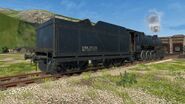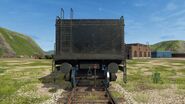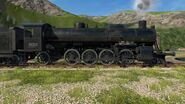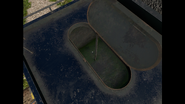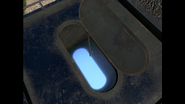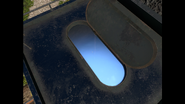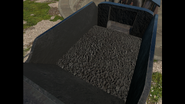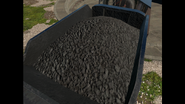S282
The S282 is one of two operable steam locomotives in the game, the other being the S060. It is comparable to the DE6 locomotive in terms of load rating and is generally cheaper to run, but at a cost of higher workload during operation. It requires obtaining a proper license before operation is allowed. After getting the licence, the user must purchase a shovel and lighter.
The Locomotive (S282-A)
The locomotive is driven by high-pressure steam at a maximum of approximately 14 bar (203 PSI), generated from heating water in the boiler by burning coal in the locomotive's firebox. The locomotive has a 2-8-2 wheel configuration, with 2 leading wheels, 8 coupled driving wheels and 2 trailing wheels under the cab supporting the weight of the cab and firebox, hence the '282' in its name. The locomotive holds 600 units of sand.
The Tender (S282-B)
The locomotive is operated coupled to a tender, which holds main stock of coal and water. The coal is shovelled from the tender into the locomotive's firebox, and water is added to the locomotive's boiler by operation of a injector valve in the cab. The tender holds 20,000 units of water and 10,000 units of coal.
The tender's water level can be checked by climbing on top and opening the water filler hatch towards the rear. The remaining water can be viewed through the hatch. The remaining coal amount is directly visible while on top of the tender.
The tender, like all other rolling stock in-game, has a handbrake, which can be found on the tender footplate.
If the tender should become uncoupled from the locomotive, it can be recoupled by reversing the locomotive into the tender however, the S282 is unable to maintain brake pressure without the tender.
Controls and Instruments
Cut-off
The cut-off is a large cylindrical handle which controls the torque and coal efficiency of the locomotive. Pulling the cut-off closer to the centre will increase coal efficiency though at the cost of decreased torque. Pulling the cut-off further to the bottom or top will increase torque at the cost of more coal consumption. Higher torque can result in wheelslip.
The cut-off affects the power-to-speed ratio of the cylinders, by changing the timing of introduction of steam into the cylinder along the piston's stroke. The action of the cut-off is achieved through a Walschaerts Valve Gear mechanism on each side of the locomotive.
Regulator
The regulator is located above the firebox doors, as a long handle pointing out and towards the driver of the locomotive. The regulator dictates how much steam is being directed into the cylinders. Pulling the regulator backwards increases throttle, while pulling it forwards decreases throttle.
Water Gauge
The water gauge in the cab measures the water in the boiler, although it does not measure the capacity of the boiler in its entirety, but rather a smaller range of it. I.e. when the water level is at the bottom of the gauge, this does not necessarily mean that the boiler is empty.
The water gauge is only accurate when on level track while stationary and varies drastically when the locomotive is on a gradient, due to water sloshing around in the boiler. overfilling the boiler (priming) or running dry (activated fusible plug and boiler explosion) are simulated, although boiler explosions may happen for other reasons than running dry. (A severe derailment can also cause a boiler explosion for example)
Whistle
The whistle is located above the reverser, as a brown rope. Pulling the rope creates a sound signal by letting steam flow through the whistle on the boiler. The further the rope is pulled down, the higher the tone gets.
Valves & levers
The locomotive has three red valves located to the left of the regulator, along with the controls for the headlamp, rear headlamp and gear light. Three other valves for the dynamo, air pump and lubricator are turned off by default and must be switched manually.
Blowdown
The first valve from left to right is the water dump valve. When rotated, water will exit the boiler, thus lowering water level in the water gauge. The speed of the water can be adjusted, depending on how far the valve is turned.
Bell
The second valve is the Bell. Upon rotation, steam will start to ring the bell.
Blower
The third valve is the Blower. The blower can be used to boost the fire. This is done using steam pressure. Turning the blower further uses more steam and a hotter fire uses more coal. It is recommended that it only be used when the engine is stationary.
Coal dump
Replacing the "fire out" valve on the the S282, the coal dump is a lever to the left of the firebox doors that dumps coal that is currently in the firebox.
Brakes
The locomotive is equipped with two brakes: the independent brake and the train brake. These are located directly to the right of the firebox, with the independent brake more to the front of the cab. The independent brake is used to slow down the locomotive. The train brake is used to slow down the train and all the wagons connected with brake pipes. The train brake on the S282 is a "Non self-lapping" brake, which the DM3 also has. It has 3 positions: release, lap, and apply. Release releases brake pressure, apply adds brake pressure, and lap holds the brake pressure at the point the brake pressure was when the lever was put into lap.
Injector
The injector is located above the valves and used to let water enter the boiler. Turning the injector valve further increases water flow speed. Injecting water cools the boiler, so when injecting water, less steam is generated.
Sander
The sander is located to the right of the fire doors. It is used to deploy sand on the driving wheels of the locomotive. This gives the wheels more grip, allowing the train to accelerate faster on flat ground and steep hills. The sander is especially useful when carrying heavy trains or climbing steep mountains. The sander has its own gauge underneath it. In builds 93 & 94 the gauge has no unit of measurement & no numbers.
Fire Doors
The fire doors are in the middle of the cab, underneath the regulator, as a stick pointing to the right side of the cab. It is used for access to the firebox. It can be opened and closed.
Damper
The damper is located underneath the brakes, depicted as a stick with a 90° curve pointing towards the tender. The damper has the same purpose as the blower, to boost or cool the fire, but the damper doesn’t run on steam. The damper is used while driving. Using the airflow from the moving of the train, the damper allows the fire's temperature to be controlled, as to not burn excess coal.
Cylinder Cocks
The Cylinder cock lever is on the right side of the cab, directly next to the train brake. It allows water to leave the cylinders, which is important, since water can't be compressed like steam. Not operating the cylinder cocks upon startup can damage the cylinders. A sloshing sound will play when water is in the cylinders.
Dynamo
The Dynamo uses steam to generate electricity to power the headlamp and lights. It's valve can be found on the top of the boiler. When on, a Buzzing sound can be heard.
Air Compressor
The Air Compressor compresses air to build brake pipe pressure. It's valve is found on top of the right cylinder.
Lubricator
The Lubricator oils the locomotive's valve gear. It's valve is found to the right of the S282's vehicle plaque.
Headlight Switch
The Headlight Switch controls the mode of the headlight & rear light. it has 7 positions (from top to bottom): high beam front, normal front, day running front, off, day running rear, normal rear, and high beam rear.
Gear Light Button
The Gear light button turns on a light below the right side of the cab, which allows the wheels & valve gear to be visible at night.
Trivia
This trivia is outdated and needs to reflect the revamped S282.
- The S282 appears similar to the American-made USATC S200 locomotive, an export design produced during WW2 for operations in the Middle East in 1941-42. This resemblance is likely unintentional.
- According to the nameplate on the locomotive, it was built in 1938.
- In reality, a comparable steam locomotive is always crewed by at least 2 individuals - a driver and a fireman. Ingame, however, the player must fill the role of both.
- From build 81, and until the bug was fixed in build 94, damage on the tender was disabled due to a bug that caused the tender to take excessive damage.
- The connecting rods on the driving wheels are incorrectly rotated 180 degrees apart from one another, when they should be rotated 90 degrees apart (as they would be in real life).
- Unlike the DE2 and DE6, the S282 has no warning light in the cab to indicate if the engine needs service so the only way to tell if it needs service is if it doesn't build up steam pressure despite the fire being lit and water being in the boiler.
- Likewise, the S282 does not have a warning light for incorrectly set brake pipes or brake valves.
History
- Simulated efficient coal management during accelerated steam engine startup (Halves the amount consumed)
- Made partial shovel unloading possible
- Reduced cost of coal by 75%
- Fixed cylinder cock steam particles being out of sync with the piston cycle on S282
- Removed accumulation of water in cylinders when the steam vehicle is in motion (IRL the tiny amount of condensing water gets expelled with each piston cycle)
- Fixed S282 fire not going out when coal is exhausted
- Fixed firebox temperature not returning to boiler water temperature when fire is out
- Adjusted S282 so it doesn’t go over 120 km/h
- Reduced price of S282A/B subsystems (and thus repair costs)
- Fixed water in cylinders being audible at large distances
- Lowered dynamos sound volume
- Fixed exploded S282 retaining red valves and labels
- Added numbers to S282 sand gauge
- Allowed adding coal to firebox via the driving UI when the firebox doors are closed
- Reduced S282 resource consumption (coal, water) by 20%
- Reduced S282 blower power and steam consumption by 75% (Mostly noticeable with the startup time)
- Increased S282 coal consumption when the fire is lacking air (Indicated by dark chimney smoke)
- Increased S282 indicated firebox temperature at low combustion rate
- Enabled body and wheels damage on S282B (Tender)
- Fixed S282 bad brake gauge needle alignment
- Fixed S282 chimney smoke clipping through the model
- Fixed the crown sheet sizzling sound continuing to play after boiler explosion
- Complete remake of the S282 (Locomotive and tender remodeled)
- Steam simulation redone (Cut-off, Cylinder Cocks, Crown Sheet, Water Dynamics, Air flow)
- New locomotive features (Lights, Bell, Openable front cab windows)
- Improved tender water hatch to be easily grabbable in nonVR
- Fixed tender sometimes spawning uncoupled from the steam locomotive
- Teleporting to the steamer and shunter now puts you straight to the driver position
- Fixed steamer cab teleport gizmo showing up when leaning against the tender
- Made tender invulnerable until excessive damaging is fixed
- Updated steamer UV layout to make skin modding easier
- Will break existing steamer skin mods
- Fixes steamer not spawning at IMW
- Steam locomotive now generates air brake pressure using steam pressure from boiler
- Increased power, reduced wheelslip
- Added independent brake to locomotives (more responsive than train brake)
- Made “Fire Out” valve work (if temp. under 100 deg)
- Temporarily removed locomotive headlights until they’re finished
- Improved whistle rope grabbing
- Locomotives now despawn after 2 hours of no use
- Locomotive and tender now need to be serviced separately
- Fixed coal lumps not disappearing when thrown into firebox


